Archive for June, 2013
» posted on Saturday, June 29th, 2013 by Linda Lou Burton
Attracted To Des Moines
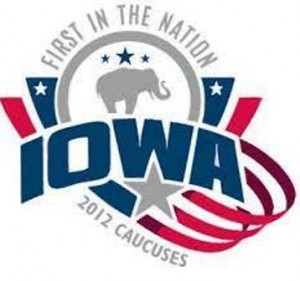 Linda Burton posting from Des Moines, Iowa – When you decide to run for President, where do you go first? Hint: Des Moines, Iowa. Iowa caucuses have been the first major electoral event in nominating the President of the United States since 1972; presidential candidates tend to set up headquarters in Des Moines early on. But politics isn’t the only reason people are attracted to Des Moines; it’s a major center for the insurance industry too; called the #1 spot for US insurance companies, and dubbed the third largest insurance capital of the world. Forbes magazine ranked Des Moines the Best Place for Business in 2010, and #1 in America’s Best Cities for Young Professionals in 2011. Do the names Principal Financial Group, Aviva Insurance, the Meredith Corporation, Ruan Transportation, EMC
Linda Burton posting from Des Moines, Iowa – When you decide to run for President, where do you go first? Hint: Des Moines, Iowa. Iowa caucuses have been the first major electoral event in nominating the President of the United States since 1972; presidential candidates tend to set up headquarters in Des Moines early on. But politics isn’t the only reason people are attracted to Des Moines; it’s a major center for the insurance industry too; called the #1 spot for US insurance companies, and dubbed the third largest insurance capital of the world. Forbes magazine ranked Des Moines the Best Place for Business in 2010, and #1 in America’s Best Cities for Young Professionals in 2011. Do the names Principal Financial Group, Aviva Insurance, the Meredith Corporation, Ruan Transportation, EMC  Insurance Company, and Wellmark Blue Cross Blue Shield ring a bell? They are headquartered in Des Moines. How did this up-and-going city get its start, and where did it get its name? Who got here first? The city was incorporated as Fort Des Moines September 21, 1851, so named because there was a fort here at one time. The word “Fort” was dropped in 1857 and it’s been Des Moines ever since; as for the fort, it was abandoned in 1846 but was the core from which the city grew. Its exact location was lost over time as flood deposits from the Des Moines
Insurance Company, and Wellmark Blue Cross Blue Shield ring a bell? They are headquartered in Des Moines. How did this up-and-going city get its start, and where did it get its name? Who got here first? The city was incorporated as Fort Des Moines September 21, 1851, so named because there was a fort here at one time. The word “Fort” was dropped in 1857 and it’s been Des Moines ever since; as for the fort, it was abandoned in 1846 but was the core from which the city grew. Its exact location was lost over time as flood deposits from the Des Moines  River covered it over, but recently discovered remains are now being excavated. At Site 13PK61, the Office of the State Archaeologist is methodically unearthing foundations, fireplaces, tools, and food debris left by the fort’s occupants and the residents of the early town of Fort Des Moines, as well as earlier Indian people that may have lived in the area. Which brings me to the prehistoric villages. » read more
River covered it over, but recently discovered remains are now being excavated. At Site 13PK61, the Office of the State Archaeologist is methodically unearthing foundations, fireplaces, tools, and food debris left by the fort’s occupants and the residents of the early town of Fort Des Moines, as well as earlier Indian people that may have lived in the area. Which brings me to the prehistoric villages. » read more
» posted on Thursday, June 27th, 2013 by Linda Lou Burton
Catching On
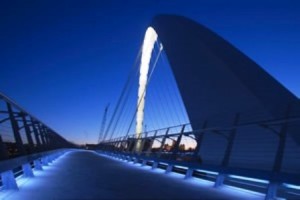 Linda Burton posting from Des Moines, Iowa – We try to avoid catching a cold, but we are happy when we catch a fish. We say to a friend “I’ll catch you later,” and here in Des Moines, the catch-phrase of the year seems to be “catching” every thing good there is in town. As I thumbed through the “Official Guide” for spring/summer 2013, a publication of the Visitors Bureau, I started to get the idea. Catch A River View, for instance. Des Moines has two rivers downtown, the Des Moines and the Raccoon, and the city apparently takes full advantage of what that means. Like the Principal Riverwalk, a system featuring lighted, landscaped public spaces, world-class public
Linda Burton posting from Des Moines, Iowa – We try to avoid catching a cold, but we are happy when we catch a fish. We say to a friend “I’ll catch you later,” and here in Des Moines, the catch-phrase of the year seems to be “catching” every thing good there is in town. As I thumbed through the “Official Guide” for spring/summer 2013, a publication of the Visitors Bureau, I started to get the idea. Catch A River View, for instance. Des Moines has two rivers downtown, the Des Moines and the Raccoon, and the city apparently takes full advantage of what that means. Like the Principal Riverwalk, a system featuring lighted, landscaped public spaces, world-class public  art, and unique pedestrian bridges and pathways that connect 300 miles of Central Iowa trails. At the north end is the “Iowa Women of Achievement Bridge,” a stunning arched span with two separate pathways – one for walkers and joggers, and one for bicyclists. To the south is the now-people-friendly Union Railroad Bridge, repainted its original “caboose red,” with cantilevers on either side allowing pedestrians to stop and “catch” the view. In between, both sides of the river offer destination points: the Brenton Skating Plaza with winter skating and summer events; the Long Look Garden with formal landscaping and a grand staircase; the Hansen Triangle with bronze sculpture and fountain; the Hub Spot, The
art, and unique pedestrian bridges and pathways that connect 300 miles of Central Iowa trails. At the north end is the “Iowa Women of Achievement Bridge,” a stunning arched span with two separate pathways – one for walkers and joggers, and one for bicyclists. To the south is the now-people-friendly Union Railroad Bridge, repainted its original “caboose red,” with cantilevers on either side allowing pedestrians to stop and “catch” the view. In between, both sides of the river offer destination points: the Brenton Skating Plaza with winter skating and summer events; the Long Look Garden with formal landscaping and a grand staircase; the Hansen Triangle with bronze sculpture and fountain; the Hub Spot, The 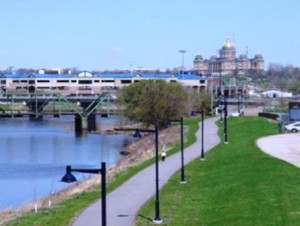 Promenade, and various waterfront trails. The Guide goes on to list other “catches” of Des Moines – from arts to action; even lazy things to do. I started a list of events to catch while I’m here and bingo, right off the bat I found the 15th Annual Arts Festival, coming up this weekend at Western Gateway Park. Painting, photography, sculpture, metalwork, music, kid’s crafts, food, and about 200,000 people. Wow. » read more
Promenade, and various waterfront trails. The Guide goes on to list other “catches” of Des Moines – from arts to action; even lazy things to do. I started a list of events to catch while I’m here and bingo, right off the bat I found the 15th Annual Arts Festival, coming up this weekend at Western Gateway Park. Painting, photography, sculpture, metalwork, music, kid’s crafts, food, and about 200,000 people. Wow. » read more
» posted on Tuesday, June 25th, 2013 by Linda Lou Burton
Windmills Of My Mind
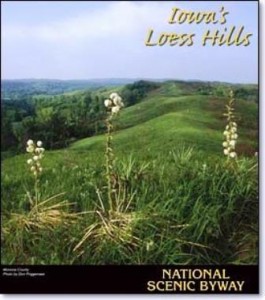 Linda Burton posting from Des Moines, Iowa – A thunderclap knocked me out of bed; a 9 on a scale of 10. Lincoln had stormed me in; Lincoln was storming me out. But it rapidly moved east; by the time I dressed it was starting to clear. The cats were the fourth load; the sun came out and the humidity came up; I turned the cooler on and set the GPS for Des Moines. A mile to the freeway; I-80 East was all I had to remember today. Cross the Platte River, edge around Omaha, cross the Missouri River, and the Journey entered its 35th state. The minute I crossed the line the landscape changed. I entered the Loess Hills of western Iowa, a unique land formation adjacent to the Missouri River Valley. Though deposits of “loess” are found around the world, nowhere else but in
Linda Burton posting from Des Moines, Iowa – A thunderclap knocked me out of bed; a 9 on a scale of 10. Lincoln had stormed me in; Lincoln was storming me out. But it rapidly moved east; by the time I dressed it was starting to clear. The cats were the fourth load; the sun came out and the humidity came up; I turned the cooler on and set the GPS for Des Moines. A mile to the freeway; I-80 East was all I had to remember today. Cross the Platte River, edge around Omaha, cross the Missouri River, and the Journey entered its 35th state. The minute I crossed the line the landscape changed. I entered the Loess Hills of western Iowa, a unique land formation adjacent to the Missouri River Valley. Though deposits of “loess” are found around the world, nowhere else but in 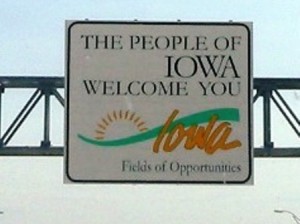 China are areas of windblown silt higher than in Iowa. The Loess Hills encompasses over 640,000 acres of land; 10,000 acres are designated “Loess Hills National Natural Landmark.” People flock to visit the outstanding prairie-and-forest-covered bluffs and the archaeologically rich hills; in 2008 the State Archaeologist recorded over 1,500 inventoried sites. I stopped at the Iowa Welcome Center about 20 miles in; a marker there told of historic Council Bluffs, so named for an 1804 meeting of the Lewis and Clark Expedition with the Otoe Tribe. The Missouri and the Platte,
China are areas of windblown silt higher than in Iowa. The Loess Hills encompasses over 640,000 acres of land; 10,000 acres are designated “Loess Hills National Natural Landmark.” People flock to visit the outstanding prairie-and-forest-covered bluffs and the archaeologically rich hills; in 2008 the State Archaeologist recorded over 1,500 inventoried sites. I stopped at the Iowa Welcome Center about 20 miles in; a marker there told of historic Council Bluffs, so named for an 1804 meeting of the Lewis and Clark Expedition with the Otoe Tribe. The Missouri and the Platte, 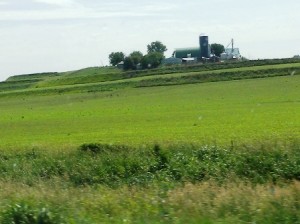 so significant to explorers and settlers in the westward movement. Back on the road, bright green slopes began to fill my view, different from the farms I’d seen in Kansas and Nebraska. They were terraced farms; gentle contours edged with grasses in between the crops. And then, a truck whizzed by, hauling a giant blade. A blade for a wind turbine? Wind farms in Iowa? » read more
so significant to explorers and settlers in the westward movement. Back on the road, bright green slopes began to fill my view, different from the farms I’d seen in Kansas and Nebraska. They were terraced farms; gentle contours edged with grasses in between the crops. And then, a truck whizzed by, hauling a giant blade. A blade for a wind turbine? Wind farms in Iowa? » read more
» posted on Sunday, June 23rd, 2013 by Linda Lou Burton
Go Big Red
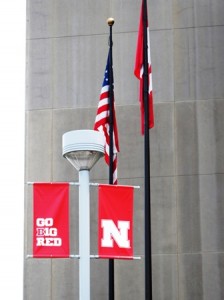 Linda Burton posting from Lincoln, Nebraska – I stared at them all during lunch. Red back-to-back “N”s all across the wall in a Mexican restaurant that didn’t have “N” in its name. So I finally asked what they meant. My server just stared at me. “Nebraska,” she finally answered, as though she couldn’t believe anyone would have to ask. “This is Nebraska. Go Big Red.” Properly chagrined, I replied, “Well I knew that. I just didn’t know why the “N”s were here.” “They are everywhere,” she laughed. “Everything in Lincoln is Nebraska Red.” And so it is; the University of Nebraska in Lincoln, the state’s oldest and largest university and the flagship of the University of Nebraska system. It all started back in 1869, two years after statehood, when it was chartered by the legislature as a land grant university under the 1862 Morrill Act. It was laid out on four city
Linda Burton posting from Lincoln, Nebraska – I stared at them all during lunch. Red back-to-back “N”s all across the wall in a Mexican restaurant that didn’t have “N” in its name. So I finally asked what they meant. My server just stared at me. “Nebraska,” she finally answered, as though she couldn’t believe anyone would have to ask. “This is Nebraska. Go Big Red.” Properly chagrined, I replied, “Well I knew that. I just didn’t know why the “N”s were here.” “They are everywhere,” she laughed. “Everything in Lincoln is Nebraska Red.” And so it is; the University of Nebraska in Lincoln, the state’s oldest and largest university and the flagship of the University of Nebraska system. It all started back in 1869, two years after statehood, when it was chartered by the legislature as a land grant university under the 1862 Morrill Act. It was laid out on four city 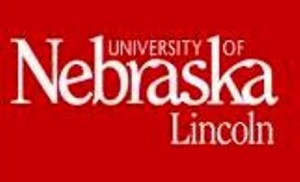 blocks and had one building. Today two campuses in Lincoln cover 2,815 acres and the university is organized into eight colleges with over 100 buildings and research facilities. City Campus is north of downtown, and south of the old fairgrounds; East Campus is two miles east-northeast of that. In addition, UNL has a 25-acre technology park on the north side of town, supplied by modern high-tech laboratories on artificial intelligence, the first
blocks and had one building. Today two campuses in Lincoln cover 2,815 acres and the university is organized into eight colleges with over 100 buildings and research facilities. City Campus is north of downtown, and south of the old fairgrounds; East Campus is two miles east-northeast of that. In addition, UNL has a 25-acre technology park on the north side of town, supplied by modern high-tech laboratories on artificial intelligence, the first 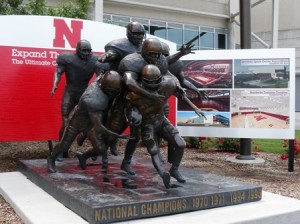 endeavor of its kind in the state. The Nebraska Innovation Campus, on 249 more acres, is being planned to house agricultural biotechnology and other life science research. And then there is the athletic program. The Cornhuskers football team has won 46 conference and five national championships; the women’s volleyball team has won three national championships. Memorial Stadium holds 85,000 and sells out every game. This year eight home games are scheduled; great joy in Lincoln over that. » read more
endeavor of its kind in the state. The Nebraska Innovation Campus, on 249 more acres, is being planned to house agricultural biotechnology and other life science research. And then there is the athletic program. The Cornhuskers football team has won 46 conference and five national championships; the women’s volleyball team has won three national championships. Memorial Stadium holds 85,000 and sells out every game. This year eight home games are scheduled; great joy in Lincoln over that. » read more
» posted on Friday, June 21st, 2013 by Linda Lou Burton
Looking Up
 Linda Burton posting from Lincoln, Nebraska – “Sit around this circle and look up,” Jamison the Tour Guide instructed the kids. They plopped to the floor and so did he, right in their midst. The rest of us kept standing; an appropriate entourage of parents, one grandma, a couple from Germany, and me. We exchanged glances, acknowledging our inability to gracefully plop; then grandma and I found a bench. Meanwhile, the kids kept looking up, and up, as Jamison pointed and told stories. “See the man behind the plow?” he said, and directed everyone to look at a large mural on the wall high above our heads. The children nodded. “The grass is
Linda Burton posting from Lincoln, Nebraska – “Sit around this circle and look up,” Jamison the Tour Guide instructed the kids. They plopped to the floor and so did he, right in their midst. The rest of us kept standing; an appropriate entourage of parents, one grandma, a couple from Germany, and me. We exchanged glances, acknowledging our inability to gracefully plop; then grandma and I found a bench. Meanwhile, the kids kept looking up, and up, as Jamison pointed and told stories. “See the man behind the plow?” he said, and directed everyone to look at a large mural on the wall high above our heads. The children nodded. “The grass is  very thick,” he explained, “and he is digging up sections of it with his plow, and stacking the sections. Do you know what he did with the large sections of grass, or sod?” They did not know. “They built houses,” he said joyfully, “sod houses! They stacked it up and made houses from it. Now, why do you think they used sod instead of trees?” The children looked at each other, and looked again at the mural. They did not know the answer. “We have trees in Lincoln now,” he continued, “but many years ago, there were no trees, just prairie grass. No trees! Somebody planted all the trees you see today. There was no wood to build with, so the
very thick,” he explained, “and he is digging up sections of it with his plow, and stacking the sections. Do you know what he did with the large sections of grass, or sod?” They did not know. “They built houses,” he said joyfully, “sod houses! They stacked it up and made houses from it. Now, why do you think they used sod instead of trees?” The children looked at each other, and looked again at the mural. They did not know the answer. “We have trees in Lincoln now,” he continued, “but many years ago, there were no trees, just prairie grass. No trees! Somebody planted all the trees you see today. There was no wood to build with, so the 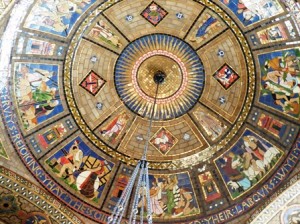 settlers used what they had. And that was sod.” There was a group “ohh” from the children as they thought about that. Jamison continued with the beginnings of Nebraska, pictured right there in the vestibule of the capitol. The capitol’s art is “themed” from beginning to end, reflecting the values of the people of Nebraska. There’s hushed behavior here; the building feels cathedral-like; especially looking up. » read more
settlers used what they had. And that was sod.” There was a group “ohh” from the children as they thought about that. Jamison continued with the beginnings of Nebraska, pictured right there in the vestibule of the capitol. The capitol’s art is “themed” from beginning to end, reflecting the values of the people of Nebraska. There’s hushed behavior here; the building feels cathedral-like; especially looking up. » read more
» posted on Wednesday, June 19th, 2013 by Linda Lou Burton
Life Is Right
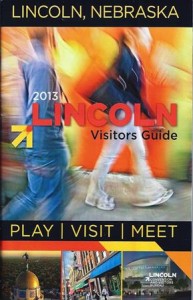 Linda Burton posting from Lincoln, Nebraska – “I’m not stuck-up. I’m just deaf.” Such was the comment made to me by the gentleman to my left, as his wife leaned across to chat. We each were waiting for a table; the restaurant was crowded and a conversation had naturally begun. At least, between the wife and me. Until the husband chimed in, concluding, “That’s why I’m not talking.” He looked directly in my eyes as he spoke, and gave me a quirky smile as though to apologize. His wife smiled too, and gave him a love pat on the shoulder; I smiled back and thanked him for saying that. It was a comfortable moment. And not unusual for Lincoln, I’m finding. Everyone comes across friendly, and open. If people in a community are friendly, and open, then is it logical to conclude that the people in that community are happy? That life is right? The Lincoln Chamber of Commerce believes it; in fact, they have set up a website – www.lifeisright.com – to serve as an outlet for local residents, and visitors, to express why they believe life feels “right” in Lincoln. At “Shout Lincoln” you can record your comments; at “Picture Lincoln” you can add your favorite Lincoln photos. And “Brand Lincoln” is an innovative approach that helps local businesses and organizations customize the Lincoln logo to perfectly fit their
Linda Burton posting from Lincoln, Nebraska – “I’m not stuck-up. I’m just deaf.” Such was the comment made to me by the gentleman to my left, as his wife leaned across to chat. We each were waiting for a table; the restaurant was crowded and a conversation had naturally begun. At least, between the wife and me. Until the husband chimed in, concluding, “That’s why I’m not talking.” He looked directly in my eyes as he spoke, and gave me a quirky smile as though to apologize. His wife smiled too, and gave him a love pat on the shoulder; I smiled back and thanked him for saying that. It was a comfortable moment. And not unusual for Lincoln, I’m finding. Everyone comes across friendly, and open. If people in a community are friendly, and open, then is it logical to conclude that the people in that community are happy? That life is right? The Lincoln Chamber of Commerce believes it; in fact, they have set up a website – www.lifeisright.com – to serve as an outlet for local residents, and visitors, to express why they believe life feels “right” in Lincoln. At “Shout Lincoln” you can record your comments; at “Picture Lincoln” you can add your favorite Lincoln photos. And “Brand Lincoln” is an innovative approach that helps local businesses and organizations customize the Lincoln logo to perfectly fit their  needs. It’s a simple but very eye-catching look: an arrow pointing upward, to symbolize growth and progress, and pointing towards the Lincoln “L.” Rationally, the three segments of the arrow represent the people, places, and events that make up the community; emotionally, they stand for the success, comfort and fun you have when you live in Lincoln. And where the arrow meets the “L” is the sweet spot; that’s what signifies that “life is right” in Lincoln. » read more
needs. It’s a simple but very eye-catching look: an arrow pointing upward, to symbolize growth and progress, and pointing towards the Lincoln “L.” Rationally, the three segments of the arrow represent the people, places, and events that make up the community; emotionally, they stand for the success, comfort and fun you have when you live in Lincoln. And where the arrow meets the “L” is the sweet spot; that’s what signifies that “life is right” in Lincoln. » read more
» posted on Monday, June 17th, 2013 by Linda Lou Burton
Two For One, Special
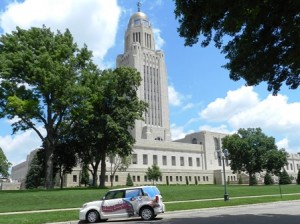 Linda Burton posting from Lincoln, Nebraska – Look carefully at my picture of the Nebraska state capitol. Do you notice anything unusual? I thought it was nice that free parking is available close by, and a sign at the bottom of the steps shows the open hours and the ADA entrance; that’s unusual, but not what I’m referring to. I’m talking about a feature unlike any other capitol in the United States. Thirty-seven capitol buildings have domes and four are skyscraper-highrise in construction. But the Nebraska capitol fits into both categories! A domed highrise, unique
Linda Burton posting from Lincoln, Nebraska – Look carefully at my picture of the Nebraska state capitol. Do you notice anything unusual? I thought it was nice that free parking is available close by, and a sign at the bottom of the steps shows the open hours and the ADA entrance; that’s unusual, but not what I’m referring to. I’m talking about a feature unlike any other capitol in the United States. Thirty-seven capitol buildings have domes and four are skyscraper-highrise in construction. But the Nebraska capitol fits into both categories! A domed highrise, unique 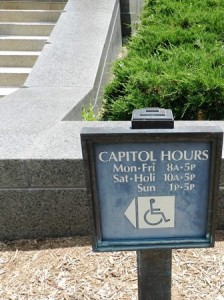 and striking. It’s not the tallest of the three built in the 30’s when economic considerations were primary and Art deco was the design of choice, nor was it the least expensive to build, but it incorporates features that meet the needs of Nebraska citizens with both efficiency and beauty. And behind every element that is functional lies a deeper meaning of what Nebraska is all about. Take that golden dome, for instance. It is symbolic of the sun, so central to the weather of the prairie state; its reflective surface even changes
and striking. It’s not the tallest of the three built in the 30’s when economic considerations were primary and Art deco was the design of choice, nor was it the least expensive to build, but it incorporates features that meet the needs of Nebraska citizens with both efficiency and beauty. And behind every element that is functional lies a deeper meaning of what Nebraska is all about. Take that golden dome, for instance. It is symbolic of the sun, so central to the weather of the prairie state; its reflective surface even changes 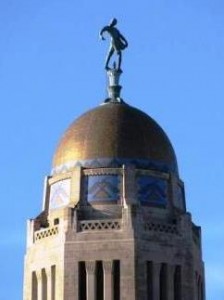 color as the weather changes. Below that, the frieze around the drum depicts thunderbirds, an American Indian symbol of thunder. Atop the dome stands the Sower, arm extended as he spreads the seed in a northwesterly direction, where most of Nebraska’s farmlands lie. These three elements together represent weather and agriculture; symbolically, they are an homage to civilizations of the past – Egyptians, American Indians, and the European settlers. From top to bottom the theme carries through, yet all the spaces are usable, and logically arranged. But it’s not just the building that’s unique, it’s also what happens inside. I’m talking about the legislative system – the only one in the country that is unicameral. » read more
color as the weather changes. Below that, the frieze around the drum depicts thunderbirds, an American Indian symbol of thunder. Atop the dome stands the Sower, arm extended as he spreads the seed in a northwesterly direction, where most of Nebraska’s farmlands lie. These three elements together represent weather and agriculture; symbolically, they are an homage to civilizations of the past – Egyptians, American Indians, and the European settlers. From top to bottom the theme carries through, yet all the spaces are usable, and logically arranged. But it’s not just the building that’s unique, it’s also what happens inside. I’m talking about the legislative system – the only one in the country that is unicameral. » read more
» posted on Saturday, June 15th, 2013 by Linda Lou Burton
In The Neighborhoods
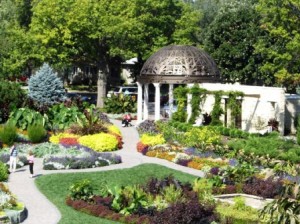 Linda Burton posting from Lincoln, Nebraska – It once was named Lancaster, but its name was changed in a political ploy. It wasn’t built on a large body of water or near any mountains. Without those moderating influences it has a highly variable climate, subject to bitter cold in the winter and heat waves during the summer. Frequent thunderstorms often produce tornadoes and blizzards are possible in the winter. It has little development outside its city limits and no contiguous suburbs. It doesn’t sound like a very appealing place to live, does it? But wait.
Linda Burton posting from Lincoln, Nebraska – It once was named Lancaster, but its name was changed in a political ploy. It wasn’t built on a large body of water or near any mountains. Without those moderating influences it has a highly variable climate, subject to bitter cold in the winter and heat waves during the summer. Frequent thunderstorms often produce tornadoes and blizzards are possible in the winter. It has little development outside its city limits and no contiguous suburbs. It doesn’t sound like a very appealing place to live, does it? But wait.  This city, built on gently rolling hills, has over 6,000 acres of parks and natural land, 7 recreation centers, 128 miles of trails, 10 public pools and 5 city golf courses. The goal of the city planners is to have a park area within a half mile walking distance of each residence in the community; in fact, the tagline says “parks and recreation are FUNdamental to the city’s quality of life.” There’s more. A canopy of 125,000 public trees covers the city; 87,000 of them line the 1,217 miles of streets. In fact, the city has been nationally recognized as a Tree City USA by the National Arbor Day
This city, built on gently rolling hills, has over 6,000 acres of parks and natural land, 7 recreation centers, 128 miles of trails, 10 public pools and 5 city golf courses. The goal of the city planners is to have a park area within a half mile walking distance of each residence in the community; in fact, the tagline says “parks and recreation are FUNdamental to the city’s quality of life.” There’s more. A canopy of 125,000 public trees covers the city; 87,000 of them line the 1,217 miles of streets. In fact, the city has been nationally recognized as a Tree City USA by the National Arbor Day 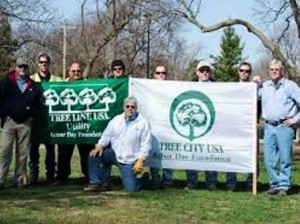 Foundation every year since 1976. And oh yes, the CDC has put it high on the list of “healthiest cities in the USA.” I’m talking about Lincoln, Nebraska, ranked as the 14th most populous capital city with 258,379 (US 2010 Census) residents who are proud to call it home. And it’s been around since 1856, even though it was Lancaster back then. Let me explain what led to the “political ploy” that changed everything. And then I’ll take you around to some of present-day Lincoln’s beautiful neighborhoods. » read more
Foundation every year since 1976. And oh yes, the CDC has put it high on the list of “healthiest cities in the USA.” I’m talking about Lincoln, Nebraska, ranked as the 14th most populous capital city with 258,379 (US 2010 Census) residents who are proud to call it home. And it’s been around since 1856, even though it was Lancaster back then. Let me explain what led to the “political ploy” that changed everything. And then I’ll take you around to some of present-day Lincoln’s beautiful neighborhoods. » read more
» posted on Thursday, June 13th, 2013 by Linda Lou Burton
Itsy Bitsy Spider
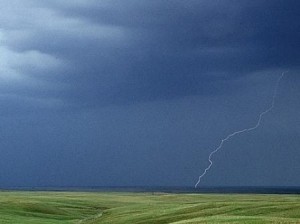 Linda Burton posting from Lincoln, Nebraska – Which frightens you most – spiders or lightning? For me it has always been lightning, like the stuff that welcomed me to Nebraska today in a frenzy of white slashing black over the green prairie to the west. Could I outrun the storm? It was moving west to east; I was traveling south to north; it was a futile contest; I lost. I’ve never seen much lightning before, as I tend to head for cover at the sound of the first thunderclap. Today I had no choice but to look. I had to keep my eyes on the road and sky; there was no place to stop; only open prairie.
Linda Burton posting from Lincoln, Nebraska – Which frightens you most – spiders or lightning? For me it has always been lightning, like the stuff that welcomed me to Nebraska today in a frenzy of white slashing black over the green prairie to the west. Could I outrun the storm? It was moving west to east; I was traveling south to north; it was a futile contest; I lost. I’ve never seen much lightning before, as I tend to head for cover at the sound of the first thunderclap. Today I had no choice but to look. I had to keep my eyes on the road and sky; there was no place to stop; only open prairie.  By sheer force nature made me realize just what amazing tricks it can do. Cloud to ground! Cloud to cloud! I counted more than a hundred streaks before the storm engulfed me with rain and then I couldn’t see a thing. Until I reached my hotel and flipped the blinker to signal left. That’s when I saw the spider and forgot the storm. My priorities changed! It was a substantial-looking brown spider, directly above the steering column and crawling down. I grabbed the first thing I could – a piece of paper with today’s driving directions – and smashed it against the spider. I missed. The spider fell to my feet. I’d heard tales
By sheer force nature made me realize just what amazing tricks it can do. Cloud to ground! Cloud to cloud! I counted more than a hundred streaks before the storm engulfed me with rain and then I couldn’t see a thing. Until I reached my hotel and flipped the blinker to signal left. That’s when I saw the spider and forgot the storm. My priorities changed! It was a substantial-looking brown spider, directly above the steering column and crawling down. I grabbed the first thing I could – a piece of paper with today’s driving directions – and smashed it against the spider. I missed. The spider fell to my feet. I’d heard tales  of wrecks caused by insects; although the storm raged around me and traffic whizzed by on either side, my basic instinct was to jump out of the car. But I didn’t. I made it into the hotel parking lot and got the cats and myself inside out of the storm, where I immediately began to read up on spiders. Because after all, that healthy brown arachnid was still in my car. » read more
of wrecks caused by insects; although the storm raged around me and traffic whizzed by on either side, my basic instinct was to jump out of the car. But I didn’t. I made it into the hotel parking lot and got the cats and myself inside out of the storm, where I immediately began to read up on spiders. Because after all, that healthy brown arachnid was still in my car. » read more
» posted on Tuesday, June 11th, 2013 by Linda Lou Burton
Taking A Shine To It
 Linda Burton posting from Topeka, Kansas – The inside of the Kansas State Capitol shines. Gleams. Glows. The marble floor is mirror-like, reflecting every hanging light; when you stand in the middle of the rotunda you can even see the dome looking back at you. But look up. There is almost too much to see; Andrea, our tour guide, pointed out the light-filtering glass bordered by shiny copper strips, the stunning copper columns, the 900-pound chandelier. Colorful murals surround all of that; look east to see the Knowledge panel, with Temperance to the left and Religion to the right. South is Power, and soldiers of war; west is Peace, with Science and Art; north is Plenty, faced by Labor and Agriculture; drama and ethics, overhead. Andrea told about the restoration; a multi-year project begun in 2002 and still underway. The shiny copper we saw today had blackened over the years; the colorful walls and stenciling had been painted over. “It was dull,” she said. “and dark. Now when you look
Linda Burton posting from Topeka, Kansas – The inside of the Kansas State Capitol shines. Gleams. Glows. The marble floor is mirror-like, reflecting every hanging light; when you stand in the middle of the rotunda you can even see the dome looking back at you. But look up. There is almost too much to see; Andrea, our tour guide, pointed out the light-filtering glass bordered by shiny copper strips, the stunning copper columns, the 900-pound chandelier. Colorful murals surround all of that; look east to see the Knowledge panel, with Temperance to the left and Religion to the right. South is Power, and soldiers of war; west is Peace, with Science and Art; north is Plenty, faced by Labor and Agriculture; drama and ethics, overhead. Andrea told about the restoration; a multi-year project begun in 2002 and still underway. The shiny copper we saw today had blackened over the years; the colorful walls and stenciling had been painted over. “It was dull,” she said. “and dark. Now when you look  around…” she waved her hand in a wonderment gesture, “well, it’s just awesome.” We agreed, and clicked our cameras. I asked about the flags I’d seen in a picture. “We still have the flags,” she replied. “But during the restoration the holders got misplaced. We’ve ordered new holders,” she laughed. The eight flags represent nations that claimed all or portions of what became the state of Kansas – Britain, France (twice), Mexico, Spain, Republic of Texas, plus of course, the United States and Kansas flags. “When we’re done with the exterior work on the dome,” Andrea continued, “we’ll open it for tours again. If you can climb 296 steps you can walk around the balcony up there.” Today however, we headed for the vintage elevator and the third floor. » read more
around…” she waved her hand in a wonderment gesture, “well, it’s just awesome.” We agreed, and clicked our cameras. I asked about the flags I’d seen in a picture. “We still have the flags,” she replied. “But during the restoration the holders got misplaced. We’ve ordered new holders,” she laughed. The eight flags represent nations that claimed all or portions of what became the state of Kansas – Britain, France (twice), Mexico, Spain, Republic of Texas, plus of course, the United States and Kansas flags. “When we’re done with the exterior work on the dome,” Andrea continued, “we’ll open it for tours again. If you can climb 296 steps you can walk around the balcony up there.” Today however, we headed for the vintage elevator and the third floor. » read more
